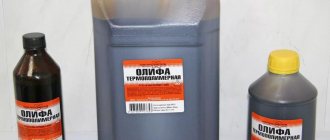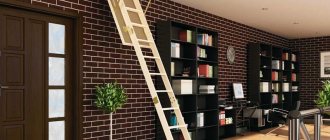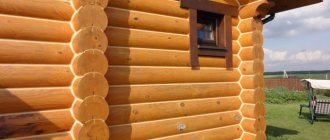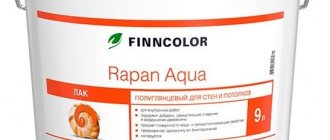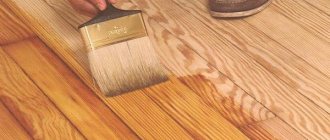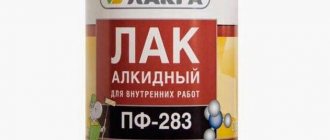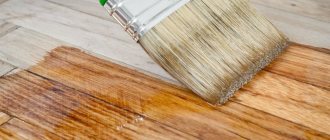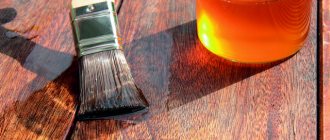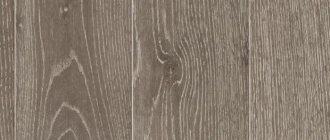Published: April 2, 2016 / Updated: March 1, 2022 The internal staircase is a functional element and a noticeable accent in the interior of the house. Most often it is built from pine wood. The designer’s task is to ensure that the architectural component blends harmoniously into the environment and performs its tasks for as long as possible. To do this, pine stairs are treated with special means and painted in accordance with the overall design. How to paint the steps of a pine staircase? What varnish, oil or stain should I cover the steps with? How to properly paint the stairs inside the house so that the coating is of high quality and durable? We will look at these and other questions further.
- 2 Features of pine wood
- 3 Why is it necessary to paint a wooden pine staircase in a house?
- 4 How to paint a pine staircase
4.1 What is the best way to paint a pine staircase: comparison table
- 6.1 Video: How to properly paint steps
- 7.1 Preparing and covering stairs with stain + video
Why do you need to treat pine stairs?
Solid pine is used in the construction and finishing of budget wooden houses. This wood is not as durable as oak, cedar or larch, but it is quite wear-resistant, more common, cheap and accessible. Pine is better than spruce because it has a denser texture and much fewer knots, which reduce the strength of the lumber. But in order for the structure to last longer, painting the pine wooden staircase will be a mandatory step. A paint or oil coating will help protect the wood, make its surface less soft and improve its decorative qualities.
Pine products are distinguished by a pleasant light golden or almost white color and a unique pattern. Depending on the method of processing the steps of a pine staircase, you can reveal the natural wood pattern or give the wood a completely different shade.
Pine has a pleasant light golden or almost white color
Features of pine wood
Working with pine is somewhat more difficult than working with cedar or oak. Soft wood requires fine sanding and careful selection of finishing agents.
The density of the material depends on the growing conditions of the tree:
- During warm periods, intensively growing fibers form a loose mass. Cold years provide hard and dense wood.
- Pine harvested in the mountains has a dense and uniform texture, while pine grown on sandy soils has a light, loose, fibrous texture.
- Northern pine is of better quality than material mined in southern latitudes.
Because of these qualities, the processing of wooden steps of a pine staircase becomes more difficult, since most of the resulting lumber absorbs the processing agents unevenly. Unsightly stains appear under the transparent coating, which is extremely unpleasant for aesthetic reasons. Resin (resin) contributes to the appearance of color spots on the surface of pine products. If the raw materials are harvested in winter, when the bulk of the resin is pumped by the tree into the root system, the fibers remain drier, cleaner and stronger. They absorb processing agents evenly. Stains and stains appear on wood cut down during the spring-summer sap flow. When brought into a warm, dry room, it begins to push the resin out. This is one of the conditions for choosing what to cover the steps of a pine staircase.
The steps of internal stairs are usually built from edged solid boards. But they often use glued boards, which have greater strength and wear resistance. The difference in the color of the lamellas from which such a board is assembled is especially noticeable. In addition, the lamellas begin to warp over time due to changes in humidity, and gaps form between them. By choosing a matte tint varnish for the steps of a pine staircase, you can hide minor visual defects and unevenness of the wood.
On glued boards the difference in the color of the lamellas is especially noticeable
If you want to leave the interfloor wooden staircase in its original natural color, you will have to use special processing agents: primer, mastic, wax, stain. A simpler option is to apply a decorative opaque coating to the pine staircase. Therefore, the answer to the question of how to paint the steps of a pine staircase is largely determined by the quality of the lumber and the desire to preserve or, on the contrary, cover up the wood pattern.
Why is it necessary to paint a wooden pine staircase in a house?
The statement that wood is beautiful and does not need painting is completely false. Wood does have an attractive appearance, but it is very vulnerable to insects, mold, hard shoe soles, dirt, and fire. The steps wear out especially quickly. Therefore, choose the right way to paint your pine staircase - then you will not only preserve the attractive appearance of the wood, but also protect it from negative influences for many years.
Stair treads wear out the fastest
Therefore, it is necessary to paint a pine staircase. If you want to see the natural grain of the wood, paint it with at least a clear varnish, but be sure to paint it!
The paint creates a hard protective coating that does not allow the wood fibers to be prematurely “wetted out.” It is inedible for bugs and unsuitable for rot and mold. Impregnations greatly enhance protection and extend service life. In addition, if you study the question of how to properly paint a pine staircase, you can give it any desired decorative qualities. Therefore, the appearance of the staircase will not deteriorate at all - on the contrary, it will become more attractive and aesthetically pleasing.
How to paint a pine staircase
Various compounds are used to process pine stairs. Which varnish for pine stairs will be better? It depends on the desired result. Some of them have only protective properties, while others change the appearance of the wood. Let's figure out how to paint a wooden pine staircase. The following can be used as a coating:
- Impregnations with antiseptic and fire retardant properties. They are made on a water, alcohol, acrylic, wax base.
- Stains (stains) for tinting wood. Pigmented impregnations do not form a surface layer, but penetrate into the fibers and make the wood texture expressive. They are made on a water, alcohol, acrylic, oil, wax, and chemical basis.
- Polishes. A transparent coating is applied to the wood, preserving its natural color and pattern, providing a radiant glossy and semi-gloss shine. Can be applied to a layer of paint or varnish to enhance the decorative effect of the coating. It is made on a water, alkyd, oil, wax base.
- Lucky. Transparent material that does not hide the natural appearance of wood. Creates a durable protective layer. It is made on an oil, alcohol, nitrocellulose base. Apply over stain.
- Enamels. They are pigmented varnishes. They form a protective colorless or decorative, glossy or matte hard layer. They have a slight odor and dry quickly.
- Paints. Create a decorative protective layer. Selected by color to match the overall interior design. They are made on an alkyd, oil, acrylic base. They mask minor wood defects and are applied to protective impregnation and previously painted surfaces.
A layer of paint masks minor wood defects
When choosing what varnish to coat the steps of a pine staircase, give preference to high-quality materials purchased in specialized stores or from manufacturers.
The best way to paint a pine staircase: comparison table
To figure out what is the best way to paint a pine staircase, let’s compare the advantages and disadvantages of various coatings, which are shown in the table below.
| Types of paints | Advantages | Flaws |
| Oily | Moisture-resistant, rich in color, create a reliable protective film. Oil for pine stairs best reveals the natural grain of wood | They take a long time to dry, do not “breathe”, have a strong toxic odor, lose their shine in areas of wear, are afraid of alkalis, and can peel off over time |
| Enamels | Moisture resistant, form the most durable and smooth surface, dry quickly, lie flat | They provide only a matte surface and are intended for interior use only. |
| Acrylic, acrylate | Water-repellent, breathable, water-soluble, quick-drying, low odor, lays flat | They only provide a matte surface. |
| Alkyd | Moisture-resistant, dry quickly, form a smooth surface with a polishing effect | Contain solvents, have a pungent odor that lingers in the room for some time, a short-lived coating, and may peel off over time |
To ensure that the surfaces retain their attractive appearance for a long time, choose a varnish for pine stairs with a matte or semi-gloss finish. Glossy steps and railings lose their shine over time due to constant use and look untidy. You won’t be able to quickly refresh the color; you’ll have to sand and repaint all surfaces.
Brief characteristics of yacht varnishes:
| Place | Name | A country | Varnish type | Type of varnish | Consumption per layer, sq.m | 0.7-1l, rub | 9l, rub | Layers |
| 7 | Neomid Yacht | Russia | universal | alkyd-urethane | 10-13 | 295 | 2750 | 3 |
| 6 | Belinka Yacht | Slovenia | universal | alkyd-urethane | 10-12 | 570 | 4700 | 2 |
| 5 | Eurotex | Russia | universal | urethane-alkyd | 8-13 | 280-370 | 3200-4050 | 2-4 |
| 4 | Prestige | Russia | for outdoor use | alkyd | 7-9 | 250-300 | 2900-3200 | 2 |
| 3 | Marshall Protex Yat Vernik | Türkiye | for outdoor use | urethane-alkyd | 14-16 | 440-480 | 3500-4200 | 2 |
| 2 | Pinotex Lacker Yacht | Holland | universal | alkyd-urethane | 10-15 | 650 | 4900-6300 | 2 |
| 1 | Tikkurila Unica Super | Finland | universal | urethane-alkyd | 12-14 | 650-950 | 7050-7750 | 2 |
Materials and tools for processing stairs
Before moving on to how to paint a pine staircase with your own hands, let’s look at the tools and materials that will be required for the work. To properly coat a wooden staircase with a protective compound at home, you will need:
- Primer
- Solvent, paint cleaner
- Paint, enamel, varnish
- Wood putty
- Sealant
- Masking tape
- Protective film
- Putty knife
- Napkins, rags, rags
- Scraper
- Knife
- Sanding tool, sandpaper
- Mini rolls, brushes
- Protective equipment: gloves, respirator (“petal” or others).
Kinds
The classification of varnishes is carried out according to two criteria: appearance and chemical composition. Based on the first sign, substances are divided into glossy and matte. The surface treated with a glossy composition becomes shiny, reflecting the incident light well. As a result, wooden products acquire a special beauty, requiring constant care.
The matte finish is not as flashy and takes less time to clean. The bases treated in this way are practical, hiding dirt well.
The characteristics of the chemical composition are reflected in the following types of yacht varnish.
- Alkyd. It is the most common type of yacht varnish for exterior woodwork. It has good resistance to all kinds of external influences, having the ability to be deeply absorbed into the surface being treated. The disadvantages of the substance include its toxicity, which persists for a long time after application. Alkyd compounds are intended exclusively for external use.
- Alkyd-urethane. Thanks to the presence of a sufficient amount of alkyd compounds, the varnish acquires the ability to withstand the vicissitudes of the weather. The substance hardens quite quickly - within 5-6 hours. Due to the high toxicity, it is necessary to use a respirator and gloves during work to avoid poisoning the body. Alkyd-urethane compounds are used only in outdoor conditions.
- Urethane-alkyd. Due to the introduction of urethane plasticizers into the composition, the volatility of toxins is noticeably reduced. The resulting film is not afraid of significant temperature changes.
- Acrylate. Water is used as a base, so the substance is practically harmless. It is this circumstance that makes it quite expensive, since the environmental friendliness of the product is combined with the inherent strength of classic yacht varnishes. Acrylate compositions have no restrictions on their use. At the same time, they are not able to fully fulfill their initial role of protecting wooden ships.
Note! The urethane variety of yacht varnish can be safely used for finishing homes (for example, painting heated floors).
How to paint a pine staircase with paint or enamel
How to paint the steps of a pine staircase with varnish or paint? The sequence of work is as follows.
Important: All work with paints and solvents should be carried out in the warm season to ensure constant ventilation of the room.
- Cover the floor around the stairs with film. Cover the walls adjacent to the stairs with masking tape.
- Using a scraper and rags, clean the surface from dirt. If there are resin pockets in the wood, carefully cut them out with a sharp knife. Treat old paint with a cleaning agent and smooth it out with sandpaper or a sander.
Level the surface of the steps with sandpaper or a grinder
- Use a vacuum cleaner to remove any accumulated dust and wipe the surfaces with a slightly damp cloth.
- Treat knots, nail heads and screws with sealant to prevent further release of resin.
- Fill cracks, dents, and resin pockets with putty using a spatula. After the putty has dried and shrinked, repeat the procedure 1-2 more times to get a smooth surface. Sand with sandpaper and wipe off dust.
- Using a wide brush or roller, apply the primer evenly to the wood.
- After the primer has dried, apply impregnation.
- After the impregnation has dried, apply the first coat of paint. First, paint the corners with a narrow brush, then use a mini roller or a wide brush to paint larger areas. If the roller leaves a textured surface, smooth it out with a wide brush.
If the new paint strongly contrasts with the previous one or with the color of the wood, for the first layer prepare it more liquid, diluting it with a solvent by 10–20%. Then the paint will lie smoothly, without longitudinal stripes or marks.
- After the first layer has dried, apply the finishing coat of paint in the same order.
- At the same time, paint the railings, balusters, and vertical side surfaces with a brush. You can apply paint with a brush along and across the direction of the fibers, but the final strokes should only be longitudinal. So that during work you can use the stairs to the upper floor, paint the steps one at a time. Mark unpainted areas that you will walk on with colored masking tape. After the first part of the steps has dried, transfer the marks to them and start painting the second half.
- The varnished pine staircase must be completely dry. This period is indicated by the manufacturer on the packaging of the varnish or oil. But, as practice shows, the drying speed is affected by the conditions in the room. Therefore, it is better to wait a couple more days so that the painted surface is guaranteed to dry.
Video: How to properly paint steps
Conclusion
After drying, the varnish forms a durable protective film on the treated surface, which protects the surface from mechanical damage, abrasion, moisture and the effects of solar ultraviolet radiation. Yacht varnishes are more wear-resistant and elastic compared to parquet flooring. However, at low temperatures the properties of the varnish change and it becomes brittle. When choosing a product, you should take this point into account, as well as the technical characteristics of the coating, composition and recommendations for use.
How to paint pine stair steps with varnish
If you are looking for something to cover a pine staircase in order to preserve the natural wood grain as much as possible, choose varnish or stain. The procedure for working with it differs quite a bit from coloring.
Preparing and covering stairs with stain + video
- Complete all preliminary work: protecting adjacent surfaces, cleaning, puttying, sealing, sanding.
- Using a paint brush, apply stain one step at a time. Leave for 2-3 minutes to absorb. Use a dry, lint-free cotton rag to thoroughly wipe off any excess substance, moving it only in a longitudinal direction.
- Treat all steps, balusters, and railings in the same way.
- If the color of the impregnation is uneven, repeat the treatment of the pine stairs. To ensure that the stain applies evenly, does not leave stains, and better emphasizes the texture of the wood, wet the surface with water before applying it. When working with stain, wear rubber gloves, as contact of hands with soiled rags is inevitable.
Before staining the entire staircase, experiment with the tone on a small, inconspicuous area. This will help you decide how to properly paint a pine staircase, achieving the desired decorative effect.
Finishing varnish on pine stairs (with video instructions)
The quality of the paintwork is influenced by how the final coat of paint was applied. Therefore, carefully follow the tips on how to paint pine staircase steps with varnish to get the perfect finish. The procedure for applying the finishing layer is as follows:
- Leave the staircase for 1 hour to dry completely, then proceed to apply varnish.
The interior staircase treated with stain and varnish looks so impressive
- If you do not want to make the wood darker, use wax impregnation or mastic instead of stain. After it dries, use a primer for better adhesion of the wax and varnish.
If you do not want to make the wood darker, coat it with varnish without stain
- Apply the first coat of varnish with a brush in a longitudinal direction. When working with varnish, it is not recommended to use a roller; it can leave microbubbles on the surface.
- After the first layer has dried, apply the second.
How is the chemical composition and scope related?
Once upon a time, ship varnish was used to finish the wooden hull, deck elements and internal parts. The formula was developed in such a way as to provide maximum protection for wood that is constantly exposed to the open air and in contact with water. Since the varnish was used exclusively for outdoor work, no one thought about the danger of fumes for humans.
The composition acquired the necessary qualities thanks to toluene and xylene, volatile substances of the benzene group. The compounds have an unfortunate combination of qualities: they evaporate easily and are poisonous enough to cause serious harm to health.
The skin and respiratory tract serve as the point of penetration of vapors into the human body. A small dose causes headaches and dizziness, a stronger dose irritates the mucous membranes. Severe (or long-term) intoxication leads to damage to the nervous system and internal organs, and cell degeneration.
First purpose Source stblizko.ru
The excellent qualities that a wooden surface acquires have become the reason for the spread of ship varnish for wood to other areas. It is applied to furniture and musical instruments, covering floors and panels. The composition is used for finishing walls in bathhouses and elements of gazebos; it is used to open window frames, doors, and stairs.
No matter how high-quality modern paint and varnish products are, they still remain toxic. Therefore, in interior work they are used extremely carefully, without ignoring safety regulations.

